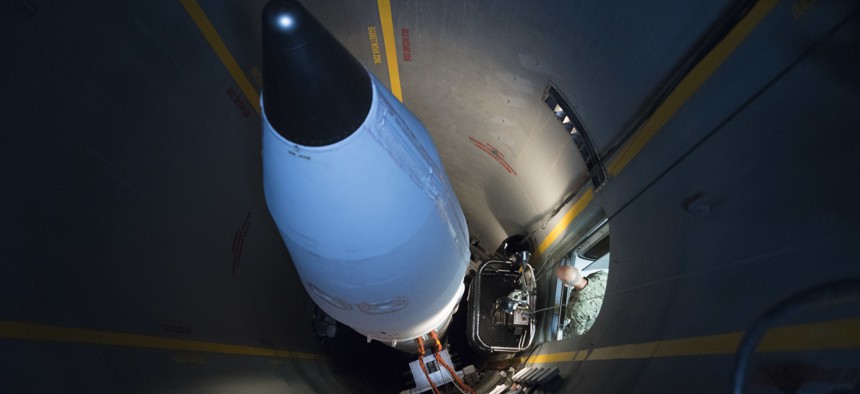
Navy Capt. Frank Bradley, executive assistant to Gen. Joseph F. Dunford Jr., chairman of the Joint Chiefs of Staff, tours Fort Greeley, Alaska, on Aug. 19, 2017, where soldiers guard Greely's ground-based interceptor missiles. DOD photo by U.S. Navy Petty Officer 1st Class Dominique A. Pineiro
On North Korea, More Missile Defense Is Not the Answer
Buying more unreliable interceptors would be a wasteful invitation to disaster.
Congress returned to Washington this week after its August break, fresh on the heels of North Korea’s sixth nuclear test, by far its largest yet. Combined with recent tests of its long-range missiles, Kim Jong-Un is clearly progressing toward his goal of having a nuclear missile that can reach the United States. Kim may not be there yet, but it is only a matter of time.
How will Congress respond? Many in the House and Senate will call for more anti-missile interceptors. The political pressure to do so is understandable and strong, as we all wish we could safely hide behind a “shield” of missile defenses, and just hunker down and wait for the storm to blow over.
But that is a dangerous illusion. Moats and castle walls proved no match for catapults. The anti-missile interceptor systems we have today are unreliable, and while simply buying more of them may make us feel better, it could leave us worse off by emboldening President Trump’s already erratic behavior. What might Trump do if he actually believes the defenses would work?
The Trump administration is faced with a long line of bad options: sanctions have not worked, U.S. military action against the North would lead to catastrophic retaliation against South Korea, and President Trump, frustrated with the North’s provocations, recently tweeted that “Talking is not the answer!” Deterrence will prevent a North Korean attack, but to halt the North’s nuclear and missile program, we must engage with Pyongyang.
Many in the U.S. Senate, such as Sen. Dan Sullivan, R-Alaska, are proposing more missile defense as the solution. The Senate’s fiscal 2018 version of the National Defense Authorization Act, which may be voted on next week, includes a misguided requirement to buy an additional 28 ground-based interceptors, to be based mainly in Alaska. It also directs the Pentagon to prepare a report on buying 100 more interceptors across the United States.
This may seem like good politics, but it is bad policy.
First, there is already a system in place. The Pentagon has already spent over $40 billion on the 36 interceptors in Alaska and California, and plans to increase that to 44 by the end of this year. How many operational missiles does North Korea have that can reach the continental United States? As far as we know, none. Kim Jong Un twice tested a long-range missile in July, the Hwasong-14, but it has not been deployed. We are ahead of this threat.
Read more: Hawaii Needs Better Missile Defense Radars, Pacific Commander Says
Related: Why Didn’t the US Shoot Down That North Korean Missile?
See also: US Missile Defenses Need Better Sensors, and Soon
As Navy Adm. Harry Harris, chief of Pacific Command, said in April, there are “sufficient” ballistic missile interceptors protecting the United States in Alaska and California.
Second, the interceptor missiles we have now are not reliable. We should fix them before buying more. Since 2004, when the Bush administration prematurely declared the system operational, half of the tests have failed to destroy their targets. And these tests are scripted for success. A real attack would include decoys and other means to fool or overwhelm the defense. No sane leader can be confident that these interceptors would work in the real world.
The Pentagon’s own testing office said that the program has “a limited capability to defend the U.S. homeland,” and the Government Accountability Office reported that the tests have been “insufficient to demonstrate that an operationally useful defense capability exists.”
Philip Coyle, the top Pentagon weapons tester in the Clinton administration, put it this way: “Based on its testing record, we cannot rely upon this missile defense program to protect the United States from a North Korean long-range missile. If anything, over-reliance on missile defenses could impede diplomatic efforts that could avoid a dangerous confrontation.”
Third, the more ineffective missile interceptors we buy, the more we convince ourselves that they will work. How else can we justify wasting so much money? But this overconfidence is dangerous. If President Trump believes he can stop a missile attack, he is more likely to escalate a conflict. This is how nations stumble into unintended wars. We can just imagine the conversation where Defense Secretary Jim Mattis tries to explain to President Trump why he can’t depend on his $40 billion anti-missile system: “If I have it, why can’t I use it?”
No, sadly, we cannot hide behind missile defense and stiff-arm North Korea. Despite what President Trump tweets, we must talk to Kim Jong-Un. Luckily, as Secretary Mattis said, “we’re never out of diplomatic solutions.”
The Senate should not promote irresponsible and unreliable anti-missile systems as a solution to North Korea, which will only waste money, line the pockets of defense contractors, and create greater risks later. Instead, the Senate might promote smart diplomacy by reminding the White House, as Sen. Sullivan has, that only Congress can authorize a preemptive military strike against North Korea, and back that up with a tough, ironclad legislative prohibition.
NEXT STORY: South Korea Is Right
